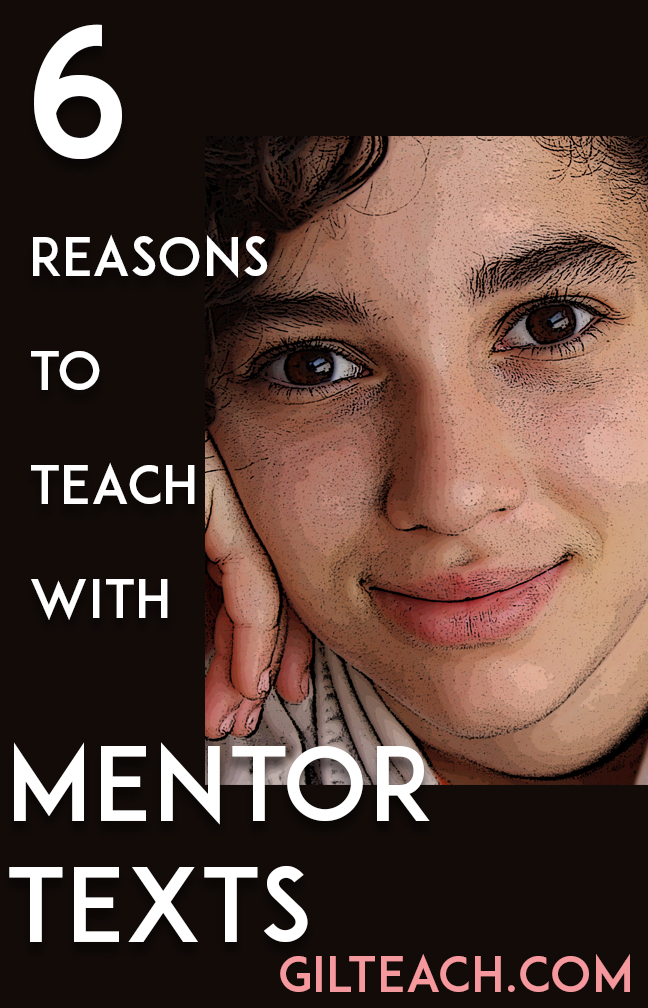6 Reasons To Teach With Mentor Texts

Starting a writing unit by examining great examples of the kinds of writing we’ll be doing is one of those ideas that I seem to forget and remember over and over again. Maybe it’s because I rush through writing plans, anxious to get to the assignment so that students can start working. Maybe it’s the effort of looking for good examples. Perhaps it’s the mistake of believing that my explanation is plenty and students shouldn’t need anything more. Or possibly it’s the idea that students will be intimidated by really good writing, thinking something along the lines of “I can’t do that so why even bother?”
It’s sort of ironic that I often forget to use mentor texts since I am someone who hates listening to instructions but loves learning from examples. ( Just show me what to do—please don’t give me elaborate step-by-step instructions.) But when I do remember to use mentor texts in my lesson plans, such as this one on argument or persuasive writing or this one on personal essays, it makes writing instruction so much easier and more effective.
Here are 6 reasons why all writing instruction should begin with mentor texts.
It gives a strong base to start the lesson. One of the reasons why I think that many people avoid writing instruction is that it seems so nebulous. Beyond the obvious and simple rules of grammar and spelling, how do you even define good writing? But when you start with a mentor text, you have something to hold up as an example of where you’re going with the assignment. Even if the mentor text isn’t exactly like what students will be creating, kids have an idea of direction and purpose
You can refer back to the mentor text whenever students get lost. Instructing students to simply write a powerful thesis statement or a catchy grabber is not helpful to the vast majority of kids. Instead, when they are stuck, you can refer back to the mentor text to look at what they did. “Remember the call to action in that last paragraph? Maybe you could do something like that?” or “Do you recall how she started the second paragraph with the vivid description? Why don’t you try that here?” are much more concrete suggestions and therefore much more helpful to most students.
Students experience more authentic writing. Blame it on the way that the young mind develops, but I’m pretty sure that many students believe that people only write when they’re in school. What they need to learn is that most people write because they have ideas—about how to stop climate change or about why their mother’s gravy is the best in the world or about how they were hurt by their friend’s actions—and they want to convey those ideas to the rest of the world. For this reason, it’s important to use real published authors as often as you can. Teaching an argument essay? Get samples from the opinion pages of the great newspapers. Want students to write powerful college application essays? Show them personal essays that are published in magazines and books. The more time that students spend with authentic writing, the better theirs will be.
Students need to understand that writing is something that you do, not something that is done to you. When students engage in deep analysis of writing, they realize just how much goes into a final draft. It’s not just one word that makes a sentence powerful, it’s that word choice combined with the structure added on to the punctuation and the vivid imagery. Often, students have the misconception that writing is something that just happens. We sit down, put some words on the page, and we’re done with it. But great writers make decisions about how they write. Rather than intimidating kids with the amount of effort that goes into good writing, this kind of examination actually shows them how writers craft their pieces. Like a sculptor who keeps coming back and refining the chunk of stone until it becomes a work of art, they too will have to work at making their writing better.
Students learn about the traits common to all great writing. No matter if they are reading newspaper articles or revealing personal essays or ancient poems, it is important for students to realize that all good writing has a few common characteristics. And the more they read and analyze what they read, the more they realize that all writers struggle to convey their ideas to readers in the most effective way they can.
Teachers get to work with their favorite writers. This might the best reason to teach with mentor texts. I’ll take any excuse to read (and reread and reread) the work of Malcolm Gladwell or David Sedaris or Amy Tan. After all, if I’m going to teach these same lessons over and over, I might as well enjoy myself. Being in the company of great writers never gets old, and I learn something myself every time I reread them.
Teaching writing is not simple or easy, but when I remember the lessons that I have learned about best practices, then I have a much better time with the experience—I just have to remember not to forget what I have remembered.
